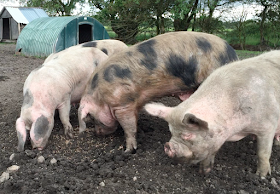My kids go back tomorrow and in an ideal world I would have a freezer full of food by now but instead this week is going to involve a bit of winging it. I will be relying on a few family favourites to get us through this week!
It is also an expensive time of the year in our house as we have just come back from holiday and everyone has had new coats, shoes, bags etc so lots of these dishes can be made at reasonable cost. Obviously if you can afford organic great, if not then home-made is still miles better than having to pull out a Tesco's pizza.
Here are some of my favourite week night dinners:
Old skool sausage pasta This is one of my reader's favourites. It can be made in bulk and frozen and although I advise buying high quality sausages which are more expensive, you can always bulk this out with extra vegetables such as chopped carrot and celery.
Meatballs (with hidden liver) The liver is optional so this can just be a simple but tasty meatball recipe.
Beef casserole It's only four months to Christmas my kids have told me so although its sunny outside I feel it's okay to put casseroles back on the menu. They do require some cooking time but can be shoved in the oven or the slow cooker in the morning or made in advance, frozen and just warmed through. If you are really rushed for time you could add potatoes or other root vegetables to the casserole to minimise cooking on the day.
Spaghetti bolognese (with added veg) Everyone has a spag bol recipe I'm sure - this is a useful one because the extra vegetables makes one feel virtuous after a summer holiday of sorbets and pub dinners. It also makes the meat go further.
Shepherds pie (but with a variation on the mash!) This is made on the stove so can be ready in as little as half an hour and is a world away from the grey mince nastiness that you get with ready made shepherd's pie which would take just as long in an oven!
Shepherds pie (but with a variation on the mash!) This is made on the stove so can be ready in as little as half an hour and is a world away from the grey mince nastiness that you get with ready made shepherd's pie which would take just as long in an oven!
Fabulous fish bites These home-made fish-fingers use almond flour as we are gluten free but if you are ok with wheat you can exchange this for normal breadcrumbs.
Lamb lollipops (kofta for kids) I love these because they take no time to prep and can be served with anything - rice, salad, baked beans! They are also great to make in bulk and then use in packed lunch boxes.
Cheeky chicken wings Wings are inexpensive but so tasty with all the goodness of the chicken skin as well! These can be served as an evening meal with home-made chips, rice, or pasta and are delicious cold for lunch the next day
The 'no it's not soup kids' noodle bowl This noodle bowl is great as you can use leftover meat from a roast and as there is very little cooking its a very quick meal. You could also use similar seasoning for a stirfry if you don't have any stock.
And if you are looking for something that is good for a Saturday when there is a bit more time for slow cooking:
Chicken tagine. This requires a few more ingredients than the other dishes but after a week of school dinners it feels like a more sophisticated dish that goes well with a bottle of white wine.
Slow cooked flat ribs You will only get these ribs from a butcher but this inexpensive cut of meat is worth seeking out. A great dish to prep and leave in the oven whilst you are out at football / ballet / general taxying of children whilst you wonder where your social life went!
Coming up next on my blog - super sugar free snacks and sweets and ideas for lunch boxes.










